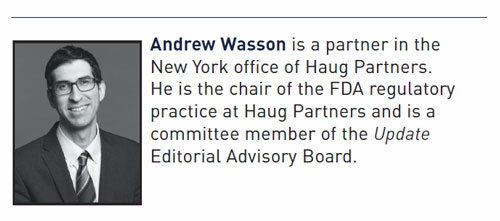
Drugs and Biologics: New Administration, New Legislation, New Precedents
Insights into this “period of substantial change,” in the words of Acting Commissioner Stephen Ostroff, are summarized by Andrew Wasson (Haug Partners), who reports on the hot issues in drugs and biologics at this year’s Annual Conference. He focuses on expert panelists’ assessment of the new administration’s impact, the implementation of the 21st Century Cures Act, and the road to the Supreme Court of Amgen v. Sandoz.
Drugs and Biologics: New Administration, New Legislation, New Precedents
by Andrew Wasson
Without question, it’s a period of substantial change,” remarked now-former Acting Commissioner Stephen Ostroff as he kicked off the 2017 FDLI Annual Conference, thereby continuing a long tradition of opening FDLI’s Annual Conference with the words of the FDA Commissioner. Changes were present in many forms. Of course, everyone was speculating about the impact of the new presidential administration on FDA. In addition, there was extended discussion about the landmark passage of the 21st Century Cures Act and the many, important changes it brings to the regulation of therapeutic products. And there was also intense interest in the Biologics Price Competition and Innovation Act (BPCIA), which enters its seventh year as law.
Trump Administration
 The potential changes to FDA brought by the Trump administration was the source of widespread discussion and speculation. Even the head of the agency was in flux. While Stephen Ostroff was serving as Acting Commissioner on the date of the conference, Dr. Scott Gottlieb assumed the role of Commissioner shortly thereafter, following the Senate’s May 9, 2017 confirmation vote.
The potential changes to FDA brought by the Trump administration was the source of widespread discussion and speculation. Even the head of the agency was in flux. While Stephen Ostroff was serving as Acting Commissioner on the date of the conference, Dr. Scott Gottlieb assumed the role of Commissioner shortly thereafter, following the Senate’s May 9, 2017 confirmation vote.
The challenges, uncertainty, and opportunities faced by the agency in light of the new administration were expressly addressed by a panel moderated by Amy Comstock Rick, the President and CEO of FDLI. The panel consisted of Kay Holcombe, Senior Vice President, Science Policy at Biotechnology Innovation Organization (BIO); Eric Lindblom, Director for Tobacco Control and Food and Drug Law at the O’Neill Institute for National and Global Health Law at Georgetown University; Susan Winckler, President of Leavitt Partners Consulting; and William Schultz, a partner at Zuckerman Spaeder, LLP. The distinguished members brought to the table long experience with the agency and deep insight into FDA policy.
The panel was asked whether it was possible to reconcile the commitment to research found in the 21st Century Cures Act with the steep cuts in science proposed by the President’s budget. On its face, there may be no way to fully harmonize the two positions. But Ms. Holcombe observed that many people who support science and research have been “energized” by the notion that someone wants to reduce funding. Consequently, this antagonism might actually result in the opposite outcome, individuals who support science have been more vocal on Capitol Hill. Along the same lines, Mr. Shultz observed that both Democrats and Republicans generally can agree on funding for science research. Indeed, 21st Century Cures passed with overwhelming bipartisan support.
The panel was also asked how much political influence has been allowed to drive FDA in the past and whether that is likely to change given the new administration. Mr. Schultz pointed out that historically it has been very unusual for the Department of Health and Human Services or the White House to overrule FDA. In fact, it has been very unusual for the Commissioner to get involved in scientific decisions at all. However, it was also pointed out that it was important to distinguish between different types of regulatory decisions, which may admit different levels of scientific versus policy involvement. For example, in theory, product approvals should admit less room for political input while decisions on regulations may admit more political input. In any event, it was observed that the influence of science versus policy is often in the eye of the beholder. To a scientist, a decision might seem primarily driven by science but to a political scientist, that same decision might seem primarily driven by policy.
The panel also discussed the impact of the recent executive order requiring that all agencies identify at least two existing regulations to be repealed for every newly proposed regulation. Ms. Holcombe acknowledged that one could be “horrified” at the notion of wholesale repeal of regulation. Yet, Ms. Holcombe also observed that it may not play out so dramatically. Some regulations are truly obsolete, some have been supplanted, and some are inconsistent with ICH guidelines. While one cannot simply tear a page out of the Federal Register at random, if there is a thoughtful process with stakeholder input, then it could be possible to generate a list of old regulations worth eliminating that could balance the necessary additional regulations. It should be noted, however, that done correctly, taking one regulation off the books is just as labor intensive as the process of promulgating a new regulation.

21st Century Cures
After years of bipartisan effort, the 21st Century Cures Act became law in December 2016. Acting Commissioner Ostroff hailed the law as “quite transformational for FDA and patients” and reported that FDA was already working hard at its implementation. FDA has its work cut out for itself—the statute nears 1,000 pages. 21st Century Cures includes provisions that: authorize the establishment of intercenter institutes; commit to elaborating the concept of patient-focused drug development; address the epidemic of opioid misuse and abuse; and provide an accelerated process to encourage cutting-edge products like regenerative medicine therapies, among many other significant provisions.
The provisions relating to regenerative medicine were of particular interest. Section 3033 of 21st Century Cures authorizes accelerated approval for regenerative medicine therapies for life-threatening diseases or conditions where preliminary clinical evidence suggests that the therapy may address unmet medical needs. Designation as a regenerative advanced therapy qualifies the therapy for expedited actions like priority review and accelerated approval, and allows the sponsor to rely on surrogate or intermediate endpoints for approval. The accelerated approval requirements also allow reliance on postapproval evidence such as real world evidence, the collection of large confirmatory data sets, and the postapproval monitoring of patients treated with the therapy pre-approval.
One particularly interesting question about the scope of the regenerative medicine therapy provisions was raised by Senior Director of Regulatory Policy from BioMarin Pharmaceutical, Adora Ndu, during the “Biologics Across the Globe: New Regulatory Challenges and Opportunities” breakout session. She noted that there has been some discussion about whether gene therapies fall within the 21st Century Cures Act’s definition of “regenerative medicine therapies.” The statute provides that regenerative medicine therapy “includes cell therapy, therapeutic tissue engineering products, human cell and tissue products, and combination products using any such therapies or products, except for those regulated solely under section 361 of the Public Health Service Act and part 1271 of title 21, Code of Federal Regulations.” Ms. Ndu concluded that gene therapies should fall within the definition. In particular, she noted that the plain statutory language only excludes therapies or products regulated “solely” under Section 361 of the PHSA. This is an interesting question that will surely gain more attention as the regenerative medicine provisions of the 21st Century Cures Act are implemented.

Biosimilars
Turning to the BPCI—now more than seven years old—we find implementation of that Act in full swing. To a standing-room-only crowd, Associate Director for Policy at FDA, Joe Franklin, provided an update on a number of policy development fronts. Mr. Franklin also provided insight into FDA’s perspective on implementation as well as an overview of ongoing and upcoming policy development. To date, the agency has approved five biosimilar products, issued final guidances, and has sixty-six programs enrolled in the biosimilar development program. Mr. Franklin also highlighted the agency’s progress on developing the concept of interchangeability, citing the agency’s draft guidance (“Considerations in Demonstrating Interchangeability With a Reference Product”) and noting that the comment period was set to close on May 19th.
The Supreme Court’s recent hearing of Amgen v. Sandoz / Sandoz v. Amgen—the first time the Court has been called to interpret the BPCIA—was also the topic of considerable discussion and speculation. Sandoz filed an abbreviated BLA that referenced Amgen’s Neupogen® (filgrastim) product. Sandoz notified Amgen that it had filed an application, which was subsequently accepted by the agency. But Sandoz informed Amgen that it had opted to not provide Amgen with a copy of its abbreviated BLA application, and thus bypass the patent negotiation provisions set out by the BPCIA (often called “the patent dance”). Sandoz also provided Amgen notice of its intended commercial marketing in July 2014, well before the approval of its product by FDA. Chad Landmon’s (Axinn Veltropp) presentation provided an update of the ongoing litigation during the biosimilars breakout session.
Amgen sued Sandoz in the Northern District of California, inter alia, for unfair competition based on two alleged violations of the BPCIA. First, Amgen alleged that Sandoz violated § 262(l)(2)(A), stating that the abbreviated BLA applicant “shall provide” to the sponsor a copy of the abbreviated application not later than twenty days after FDA accepts the application for review. Second, Amgen alleged that Sandoz’s notice of commercial marketing pursuant to § 262(l)(8)(A) was premature because it was not after the date that the biosimilar was “licensed” under the BPCIA. The district court dismissed Amgen’s unfair competition claims because it did not interpret the BPCIA to require disclosure of the abbreviated application to the reference product sponsor. In addition, the district court interpreted the BPCIA to allow an abbreviated applicant to give notice of commercial marketing prior to approval.
On appeal, a fractured Federal Circuit held that the BPCIA: (1) did not require that the abbreviated BLA applicant provide a copy of its application to the sponsor, and (2) that commercial notice must be given only after the biosimilar product has been licensed by FDA. Amgen Inc. v. Sandoz Inc., 794 F.3d 1347 (Fed. Cir. 2015). On the first issue, the Federal Circuit acknowledged that read in isolation, the language “shall provide” would require that the biosimilar applicant should provide the application to the sponsor. Yet, read in the context of the full statute, the Federal Circuit determined that the patent dance was not mandatory, reasoning that other portions of the statute expressly contemplated the consequences of not complying with the dance. On the second issue, the Federal Circuit drew a distinction between the language used by the commercial notice provision (“biological product licensed under subsection (k)”) versus the way that the statute describes biosimilar products elsewhere (as the product that is “subject of” the application). Thus, notice of commercial marketing is not effective until after the biosimilar product is “licensed” and not merely the subject of an application. Oral hearing at the Supreme Court occurred on April 26, 2017. [As Update went to press, the Supreme Court decided the case. Justice Thomas, writing for a unanimous Court, held that applicants may provide notice prior to obtaining a license, overturning the Federal Circuit.]
Update Magazine
May/June 2017








